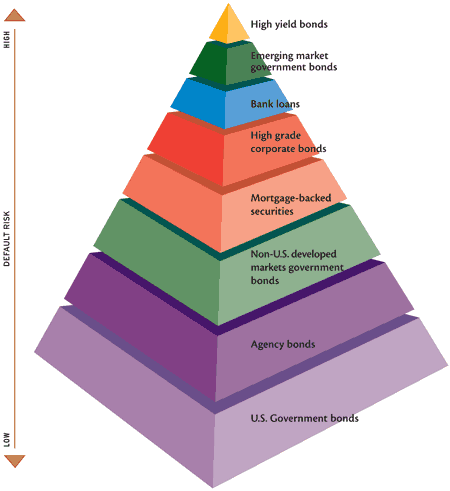Bond basics
Post on: 14 Апрель, 2015 No Comment

Contents
Features
Bonds possess a number of distinctive features. Common features include:
- Coupon rate. the interest rate paid by the bond. The rate may be fixed, floating, or inflation indexed, depending on the specific issue. The coupon date spells out the frequency of interest payments, usually biannually for US bonds. Bonds which pay a fixed coupon rate based upon the principal (face amount) are called nominal bonds .
- Maturity date. the date at which the bond principal will be repaid. Bonds are usually issued with maturities ranging from 1 year to thirty years.
- Options . the most common option involving bonds is the existence of a call feature. This feature gives the issuer the right to repay the bond before the maturity date. Since an issuer will call bonds when the interest rate is lower than the coupon rate, this feature is not advantageous to the buyer of the bond, who is then faced with reinvesting the proceeds of the redeemed bond in a lower interest rate environment. Thus it is usual for a callable bond to offer a higher coupon than an uncallable bond as compensation for the risk of early redemption. Some callable bonds also provide for a small sum to be added to the par value of a redeemed bond. Alternately, some bonds are issued with a put feature which gives the bond holder the right to force the issuer to repay the bond before the maturity date, usually on prescribed put dates
- Sinking Funds provide a means of repaying a bond issue. The issuer makes periodic payments to a trustee who retires part of the issue by purchasing the bonds in the open market. Sinking funds tend to reduce the risk of default, and thus allow the issuer of a bond to pay a lower interest rate on the bond.
- Senior vs. Subordinated Debt Senior Debt is given priority over other debt in case of default; Subordinated Debt is unsecured and, in a default, is repayable after other debts have been paid. [4]
Types of bonds
There are three main issuers of bonds in the U.S. [5]
Treasury Bonds are issued by the US treasury in groups of three maturity ranges
- Bills have a range up to one year;
- Notes have a range between one year and ten years;
- Bonds have a range greater than ten years.
Treasury bonds are usually not callable. Treasuries also carry the full faith and credit backing of the US government. The interest income is exempt from state tax. Treasuries can be purchased through brokerages and banks as well as through an individual account at Treasury Direct. Government agencies also issue debt, some of which is backed by the full faith and credit of the government and some which is not.
Treasury Inflation Protected Securities provide for inflation indexed income and inflation protection for the bond’s principal. The bond pays a fixed real interest rate based on a principal value indexed to the CPI-U inflation measure. Like all treasury bonds, inflation indexed treasuries have the full faith and credit backing of the Treasury and interest income and inflation adjusted accruals are exempt from state taxation. The inflation adjusted accruals, however, are taxable to the federal government as they accrue. This phantom income taxation makes the bonds candidates for placement in tax-advantaged accounts.
Corporate bonds are issued by corporations and are often callable. Since a corporation can default on it’s debts, corporate bonds are subject to credit risk and usually pay higher coupon interest rates over comparable term treasury maturities as compensation for this risk. [6] Corporate bonds are subject to federal and state income tax.
Municipal bonds are issued by states and localities. These bonds are subject to credit risk. [7] Many municipal bonds are also callable. The bonds are generally exempt from federal tax, although some private revenue municipal bonds are subject to the federal alternative minimum tax. A tax exempt bond is also usually state tax exempt for residents of the state issuing the bond. Due to these tax preferences, municipal bonds generally offer lower coupon interest rates than do comparable term treasuries and corporates.
Other types of bonds:
Zero Coupon bonds are accrual bonds and do not pay current coupon interest. They are issued at a deep discount from par value and compound continuously at the coupon rate. The bond holder receives the full principal amount as well as the value that has accrued from interest on the redemption date. Zero coupon bonds may be created from fixed rate bonds by financial institutions by stripping off the coupons. In other words, the coupons are separated from the final principal payment of the bond and traded independently. Individuals are taxed on the annual accrual of income, although the investor receives no current interest payment.
Asset-backed securities are bonds whose interest and principal payments are backed by underlying cash flows from other assets. Examples of asset-backed securities are mortgage-backed securities (MBS’s), which include GNMA securities backed by the full faith and credit of the US treasury, collateralized mortgage obligations (CMOs) and collateralized debt obligations (CDOs).whose underlying securities are often such assets as auto loans or credit card receivables.
High yield bonds are corporate bonds with lower credit quality than top credits. These companies are at much greater risk of default than higher quality credits and, as a result, pay higher coupon interest rates than comparable high quality corporate bonds.
Sources of return
There are three sources of return for a bond:

- Return of principal
- Interest (coupon payments)
- Interest-on-interest (reinvested coupon payments)
According to Fabozzi in the Handbook of Fixed Income Securities. 1991, p97: In high interest rate environments, the interest-on-interest component for long-term bonds may be as high as 70 percent of the bond’s potential total dollar return. In low interest rate environments, the principal is likely the largest source of value of all but the longest bonds.
Illustration of the three sources of bond return:
Risks
Each of the following risks of bonds carries some premium as compensation for bearing these risks. The amount of that premium varies according to the market’s assessment of the likelihood of the adverse event occurring.
Interest rate risk
Interest rate risk, also called price risk, is that the value of a bond fluctuates depending on the interest rate. Also known as market risk. The amount of interest rate risk assumed is measured primarily by the duration (and secondarily by convexity ). See below for more information on how bond prices react to interest rate changes.
Interest rate risk is in some sense an artifact of the traditional framework which looks at short-term returns. Over longer periods, longer duration bonds will have a more certain return than short-term bonds, as a quote from John Campbell and Luis Viceira’s academic text, Strategic Asset Allocation (pp86-87), makes clear:
If one uses conventional mean-variance analysis, it is hard to explain why any investors hold large positions in bonds. Mean-variance analysis treats cash as the riskless asset and bonds as merely another risky asset like stocks. Bonds are valued only for their potential contribution to the short-run excess return, relative to risk, of a diversified risky portfolio. A long-horizon analysis treats bonds very differently, and assigns them a much more important role in the optimal portfolio. For long-term investors, money market investments are not riskless because they must be rolled over at uncertain future interest rates.
Because unexpected inflation changes that picture somewhat, the reduced risk of longer-term bonds is primarily true when discussing inflation-protected bonds in real dollars (or nominal bonds with nominal liabilities).
Credit risk
Credit risk is a risk that the issuer of a bond may default. Also known as default risk.
Credit risk is assessed by the major ratings agencies (Moody’s, S&P, and Fitch). Each credit rating has an expected rate of default, which increases substantially in lower tiers. For a given credit rating, the default rate has historically been lower for municipal bonds than for corporate bonds. Wikipedia has tables of how the ratings compare between ratings firms and of historical default rates.
Call risk
Call risk is a risk that the issuer may call the bond, terminating a stream of income for the investor. This risk is often called prepayment risk for mortgage backed securities. Call options embedded in a bond lead to negative convexity.
Reinvestment risk
Reinvestment risk is a risk that when a bond matures or is called, an investor may have to reinvest the proceeds in a bond yielding a lower interest.
Inflation risk
Inflation risk is a risk that the interest from a bond may not keep up with inflation. TIPS are inflation-adjusted and therefore largely immune to inflation risk. Also known as purchasing power risk.
Liquidity risk
Liquidity risk is the risk that you may not be able to extract the remaining value from your bond in the timeframe needed without losing a disproportionate amount of value. Thinly-traded issues (such as most corporate, municipal, and TIPS issues) have liquidity risk. The liquidity premium is expected to rise in times of crisis. Also known as marketability risk.
The presence of liquidity risk can be seen most clearly in off-the-run Treasury bonds, where an older but otherwise identical bond trades at a reduced price/higher yield simply because it is less liquid.
Other risks
These risks are either not important for individual investors or are generally wrapped into the risks above (e.g. credit risk commonly encompasses event risk). They are included for completeness.














